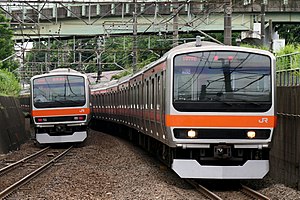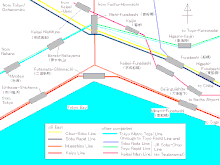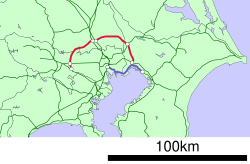Масашино
| Масашино | |||
|---|---|---|---|
| JM | |||
 Серия серии Musashino E231, ноябрь 2019 г. | |||
| Обзор | |||
| Родное имя | Масашино | ||
| Владелец | Jr East | ||
| Местный | Токио , Канагава , Сайтама , Чиба префектуры | ||
| Termini | |||
| Stations | 26 | ||
| Service | |||
| Type | Heavy rail | ||
| Operator(s) | |||
| Depot(s) | Keiyo | ||
| Rolling stock | 209-500 series, E231-0 series, E231-900 series EMUs | ||
| Daily ridership | 1,064,613 (daily 2015)[1] | ||
| History | |||
| Opened | 1973 | ||
| Technical | |||
| Line length | 71.8 km (44.6 mi) (passenger operations) 100.6 km (62.5 mi) (Total) | ||
| Track gauge | 1,067 mm (3 ft 6 in) | ||
| Electrification | 1,500 V DC overhead catenary | ||
| |||
Линия Мусасино ( 武蔵野線 , Мусасино-Сен ) -это железнодорожная линия, управляемая Железнодорожной компанией Восточной Японии (JR East). Он связывает станцию Цуруми в Йокогаме со станцией Ниши-Фунабаши в префектуре Чиба , образуя новую петлю 100,6 км (62,5 мили) вокруг Центрального Токио . Пассажирские операции ограничены частью 71,8 км (44,6 миль) между Фухухомами и Ниши-Фунабаши; Часть Tsurumi to Fuchūomommachi, называемая «Lyse Musashino South», обычно используется только грузовыми поездами. Линия является частью того, что Jr East называет «Токийской мега -петлей» (японский: 東京メガループ ) вокруг Токио, состоящий из линии Кейё , линии Мусасино, Линии Намбу и линии Йокогама . [ 2 ]
Услуги
[ редактировать ]Большинство услуг на линии Мусасино - это местные поезда, делающие все остановки. Некоторые поезда продолжаются через линию Кейи мимо Ниши-Фунабаши в Токио , Минами-Фунабаши или Кайхимакухари .
Other services include:
- Musashino: services operated between Fuchūhommachi/Hachiōji and Ōmiya
- Shimōsa: services operated between Ōmiya and Nishi-Funabashi/Kaihimmakuhari
- Holiday Kaisoku Kamakura seasonal service between Minami-Koshigaya and Kamakura
- Burari Kamakura and Yokohama Bay Area seasonal service between Iwaki and Kamakura
- Burari Takao Sansaku seasonal service between Hitachi and Takao
Station list
[edit]Tsurumi Station is considered to be the origin of the Musashino Line; trains going clockwise (toward Nishi-Funabashi) are therefore referred to as heading "down" (下り, kudari), while trains going counter-clockwise (toward Fuchūhommachi) are heading "up" (上り, nobori). This is often counterintuitive, as it results in through trains to Tokyo being labeled and numbered as "down" trains while on the Musashino Line; however, such trains switch to "up" after joining the Keiyō Line.

All eastbound (for Nishi-Funabashi) passenger trains begin service at Fuchū-Hommachi Station. For details on the Musashino South Line and other branch lines, which are freight-only sections, can be found below the passenger station list.
Musashino Line (passenger)
[edit]| No. | Name | Japanese | Distance (km) | Transfers | Location | ||
|---|---|---|---|---|---|---|---|
| Between stations |
Total | ||||||
| JM35 | Fuchūhommachi | 府中本町 | - | 0.0 | JN Nambu Line, Musashino South Line (Freight) | Fuchū | Tokyo |
| JM34 | Kita-Fuchū | 北府中 | 1.7 | 1.7 | |||
| JM33 | Nishi-Kokubunji | 西国分寺 | 2.2 | 3.9 | JC Chūō Line (Rapid) | Kokubunji | |
| JM32 | Shin-Kodaira | 新小平 | 3.5 | 7.4 | Musashino Line (Kunitachi Freight Branch) |
Kodaira | |
| JM31 | Shin-Akitsu | 新秋津 | 5.6 | 13.0 | Higashimurayama | ||
| JM30 | Higashi-Tokorozawa | 東所沢 | 2.7 | 15.7 | Tokorozawa | Saitama | |
| — | Niiza Freight Terminal | 新座貨物ターミナル駅 | 3.7 | 19.4 | Niiza | ||
| JM29 | Niiza | 新座 | 0.3 | 19.7 | |||
| JM28 | Kita-Asaka | 北朝霞 | 3.1 | 22.8 | TJ Tōbu Tōjō Line (Asakadai) | Asaka | |
| JM27 | Nishi-Urawa | 西浦和 | 5.0 | 27.8 | Musashino Line (Ōmiya Freight Branch) | Sakura-ku, Saitama | |
| JM26 | Musashi-Urawa | 武蔵浦和 | 2.0 | 29.8 | JA Saikyō Line Musashino Line (Nishi-Urawa Freight Branch) |
Minami-ku, Saitama | |
| JM25 | Minami-Urawa | 南浦和 | 1.9 | 31.7 | JK Keihin-Tōhoku Line | ||
| JM24 | Higashi-Urawa | 東浦和 | 3.7 | 35.4 | Midori-ku, Saitama | ||
| JM23 | Higashi-Kawaguchi | 東川口 | 3.8 | 39.2 | SR Saitama Rapid Railway Line | Kawaguchi | |
| JM22 | Minami-Koshigaya | 南越谷 | 4.3 | 43.5 | TS Tobu Skytree Line (Shin-Koshigaya) | Koshigaya | |
| — | Koshigaya Freight Terminal | 越谷貨物ターミナル駅 | 0.4 | 43.9 | |||
| JM21 | Koshigaya-Laketown | 越谷レイクタウン | 2.4 | 46.3 | |||
| JM20 | Yoshikawa | 吉川 | 1.9 | 48.2 | Yoshikawa | ||
| JM19 | Yoshikawaminami | 吉川美南 | 1.7 | 49.9 | |||
| JM18 | Shim-Misato | 新三郷 | 1.4 | 51.3 | Misato | ||
| JM17 | Misato | 三郷 | 2.1 | 53.4 | |||
| JM16 | Minami-Nagareyama | 南流山 | 2.0 | 55.4 | Musashino Line (Kita-Kogane, Mabashi Freight Branches) |
Nagareyama | Chiba |
| JM15 | Shim-Matsudo | 新松戸 | 2.1 | 57.5 |
|
Matsudo | |
| JM14 | Shin-Yahashira | 新八柱 | 4.1 | 61.6 | SL Shin-Keisei Line (Yabashira) | ||
| JM13 | Higashi-Matsudo | 東松戸 | 2.4 | 64.0 | |||
| JM12 | Ichikawaōno | 市川大野 | 1.9 | 65.9 | Ichikawa | ||
| JM11 | Funabashihōten | 船橋法典 | 3.0 | 68.9 | Funabashi | ||
| JM10 | Nishi-Funabashi | 西船橋 | 2.9 | 71.8 |
| ||
Ōmekaidō Station is approximately 10 minutes walk from Shin-Kodaira Station.
Musashino Freight Branch Lines
[edit]
| Name | Japanese | Distance (km) | Transfers | Location | ||
|---|---|---|---|---|---|---|
| Between stations |
Total | |||||
| Musashino South Line | ||||||
| Tsurumi | 鶴見 | - | 0.0 | Tōkaidō Line, Keihin Tohoku Line, Tsurumi Line, Tokaido Freight Line, Takashima Freight Line | Tsurumi-ku, Yokohama | Kanagawa |
| Shin-Tsurumi Yard | 新鶴見信号場 | 3.9 | 3.9 | Hinkaku Line, Nambu Line Freight Branch (for Shitte) | ||
| Kajigaya Freight Terminal | 梶ヶ谷貨物ターミナル駅 | 8.8 | 12.7 | Miyamae-ku, Kawasaki | ||
| Fuchūhommachi | 府中本町 | 16.1 | 28.8 | Musashino Line (towards Nishi-Kokubunji), Nambu Line | Fuchū | Tokyo |
| Kunitachi Branch Line | ||||||
| Shin-Kodaira | 新小平 | - | 0.0 | Musashino Line (towards Nishi-Funabashi) | Kodaira | Tokyo |
| Kunitachi | 国立 | 5.0 | 5.0 | Chūō Line | Kunitachi | |
| Omiya Branch Line | ||||||
| Nishi-Urawa | 西浦和 | ‐ | 0.0 | Musashino Line (towards Fuchūhommachi and Tsurumi) | Sakura-ku, Saitama | Saitama |
| Bessho Yard | 別所信号場 | 1.3 | 1.3 | |||
| Yono | 与野 | 3.6 | 4.9 | Tohoku Main Line (Tohoku Freight Line) | Urawa-ku, Saitama | |
| Nishi-Urawa Branch Line | ||||||
| Musashi-Urawa | 武蔵浦和 | ‐ | ‐ | Musashino Line (towards Nishi-Funabashi) | Minami-ku, Saitama | Saitama |
| Bessho Yard | 別所信号場 | ‐ | ‐ | Musashino Line Omiya Branch Line | ||
| Kita-Kogane Branch Line | ||||||
| Minami-Nagareyama | 南流山 | ‐ | 0.0 | Musashino Line (towards Fuchūhommachi and Tsurumi) | Nagareyama | Chiba |
| Kita-Kogane | 北小金 | 2.9 | 2.9 | Joban Line (towards Toride) | Matsudo | |
| Mabashi Branch Line | ||||||
| Minami-Nagareyama | 南流山 | ‐ | 0.0 | Musashino Line (towards Fuchūhommachi and Tsurumi) | Nagareyama | Chiba |
| Mabashi | 馬橋 | 3.7 | 3.7 | Joban Line (towards Mikawashima) | Matsudo | |
Rolling stock
[edit]- 209-500 series eight-car EMUs (since December 2010)
- E231-0 series eight-car EMUs (since November 2017)
- E231-900 series eight-car EMU (since 20 July 2020)[3]
Three 209-500 series sets were transferred from the Keiyō Line in 2010-2011, where they were displaced by new E233-5000 series sets and reduced from ten to eight cars per set;[4] eight additional sets were transferred from the Chūō–Sōbu Line in 2018-2019. Between 2017 and 2020, E231-0 series sets were transferred from the Chūō–Sōbu Line and the Jōban Line and reduced from ten to eight cars per set to replace the 205 series.[5] In July 2020, the sole E231-900 series set was also transferred from the Chūō–Sōbu Line and reduced from ten to eight cars.[6]
-
A Musashino Line 209-500 series EMU in October 2019
-
A Musashino Line E231-0 series EMU in January 2023
-
Musashino Line E231-900 series in August 2022
Former
[edit]- 101-1000 series 6-car EMUs (1 April 1973 - 26 October 1986)[2]
- 103 series 6-car, later 8-car EMUs (June 1980 - 8 December 2005)[2]
- 201 series 6-car EMUs (from 3 March 1986 - November 1996)[2]
- 205-0 series 8-car EMUs (from December 1991 - October 2019)
- 205-5000 series 8-car EMUs (from 2002 - 19 October 2020)
165 and 169 series EMUs were used on Shinkansen Relay services and later Musashino rapid services until 2002. 115 series EMUs were used on Musashino services from 2002 until the services were downgraded to all-stations "Local" status in December 2010. The 205-0 series sets were built from new for the Musashino Line, entering service from 1 December 1991,[2] and have six motored cars per eight-car set.[4] These were the last 205 series sets to be built from new.[2] The 205-5000 series sets were modified between 2002 and 2008 from displaced former Yamanote Line sets by adding new VVVF-controlled AC motors, and have four motored cars per eight-car set.[4] 205 series trains, both 205-0 and 205-5000 serieses, were withdrawn from Musashino Line and currently operated in Indonesia.
-
A 101 series EMU
-
A Musashino Line 103 series (low-cab type) EMU, August 2001
-
A Musashino Line 103 series EMU, May 2002
-
A 165 series EMU (right) on a Shinkansen Relay service, August 2001
-
A 115-300 series EMU set on a Musashino service, March 2004
-
A Musashino Line 205-0 series EMU in June 2006 (this particular set is actually a 205-5000, or set 145 in Indonesia)
-
205 series EMU belonging to the Musashino Line on connecting services on the Keiyō Line, January 2010. This set is now operated in Indonesia.
Freight
[edit]Locomotive types seen hauling freight trains include the Class EF64, Class EF65, Class EF66, Class EF81, Class EF200, Class EF210, Class EH200, Class EH500, Class DE10, and Class HD300.
History
[edit]The Musashino Line was initially envisioned as a "Tokyo Outer Loop Line" in a 1927 railway appropriations bill, but was not built for several decades due to World War II and its aftermath.[citation needed] Construction finally began in November 1965.[2]
In 1967, a train carrying jet fuel to Tachikawa Air Base in western Tokyo exploded while passing through Shinjuku Station[citation needed]. This disaster led to the banning of freight trains on railway lines in central Tokyo and sped the development of the Musashino Line as an alternative route[citation needed]. Because most of the line passed through sparsely populated areas, it was initially envisioned as a freight-only line. However, opposition from local residents, at the same time as the violent landowner battles plaguing Narita International Airport, led the railway authorities to agree to passenger service as well.
The first section of the line between Fuchū-Hommachi and Shin-Matsudo opened on 1 April 1973.[4] Train services were operated using 6-car 101-1000 series EMUs, which were modified specially for the line to comply with government regulations concerning fire resistance of trains operating through long tunnels, as the line included the 4,380 m (14,370 ft) Higashi-Murayama Tunnel (東村山トンネル) between Shin-Kodaira and Shin-Akitsu stations, and the 2,563 m (8,409 ft) Kodaira Tunnel (小平トンネル) between Shin-Kodaira and Nishi-Kokubunji stations.[2] Services operated at 15-minute intervals in the morning peak, and at 40-minute intervals during the daytime off-peak.[2]
The southern freight-only line from Fuchū-Hommachi to Tsurumi opened on 1 March 1976.[4] The eastern section of the line from Shin-Matsudo to Nishi-Funabashi opened on 2 October 1978.[4]
Inter-running to and from the Keiyo Line commenced on 1 December 1988.[4]
From the start of the 1 December 1996 timetable revision, all of the Musashino Line 103 series sets were lengthened from six to eight cars.[2]
On 20 August 2016, station numbering was introduced with stations on the Musashino line being assigned station numbers between JM10 and JM35.[7][8] Numbers increase in the counter-clockwise direction towards Fuchu-Hommachi.
Смотрите также
[ редактировать ]- Линия Осаки Хигаши , представляемой как аналог в районе Осаки
- Линия Aichi Loop , аналог вокруг Нагои
Ссылки
[ редактировать ]- ^ «Перепись столичной транспорта 2015 года: отчет о столичном районе» ) . ( PDF
- ^ Jump up to: а беременный в дюймовый и фон глин час я Дж Сака, Масаюки (август 2014 г.). Токио Megaloop автомобиль и история маршрутов и текущее состояние [Tokyo Megaloop: история и текущая ситуация с поездами и линией]. Tetsudō Daiya Jōhō Magazine (на японском языке). Тол. 43, нет. 364. Япония: Kōtsū Shimbun. С. 28–39.
- ^ ]« перезагрузки »на линии Мусасино в качестве прототипа автомобиля, поезда MU1, в качестве прототипа автомобиля для серии серии E231 900 . « [Бывшая серия 209 ] 20 июля 2020 года.
- ^ Jump up to: а беременный в дюймовый и фон глин Полное руководство по столичным железным дорогам - Major Jr маршрутам [ Tokyo Area Complete Railway Guide - Major Jr Lines ]. Япония: Футабаша. 6 декабря 2013 г. с. 87–97. ISBN 978-4-575-45414-7 .
- ^ Серия E231 была выпущена на линии Musashino [E231 серия появляется на линии Мусасино]. Журнал Japan Railfan (на японском языке). Тол. 58, нет. 681. Япония: Koyusha Co., Ltd. Январь 2018 г. с. 52
- ^ «[JR East] Серия E231 Бывшая формация Mitsu B901 Омия Общий центр автомобилей Участие» [[Jr East] Серия E231 Бывший набор B901 Выход из Omiya Rolling Stock Center].
- ^ в столичный район Токио» » в столичном районе Токио] (PDF . ) [ Введение « «Введите« нумерацию станции » Станция 7 декабря 2022 года. Получено 7 января 2023 года .
- ^ (7 апреля 2016 г.). Йошиказу Кусамачи , Токийский столичный . ] район
Внешние ссылки
[ редактировать ]- Станции линии Мусасино (Jr East) (на японском языке)
- Масашино
- Линии Железнодорожной компании Восточной Японии
- Железнодорожные линии в префектуре Канагава
- Железнодорожные линии в Токио
- Железнодорожный транспорт в префектуре Сайтама
- Железнодорожные линии в префектуре Чиба
- 1067 мм железные дороги в Японии
- Железнодорожные линии открыты в 1973 году
- 1973 заведения в Японии











